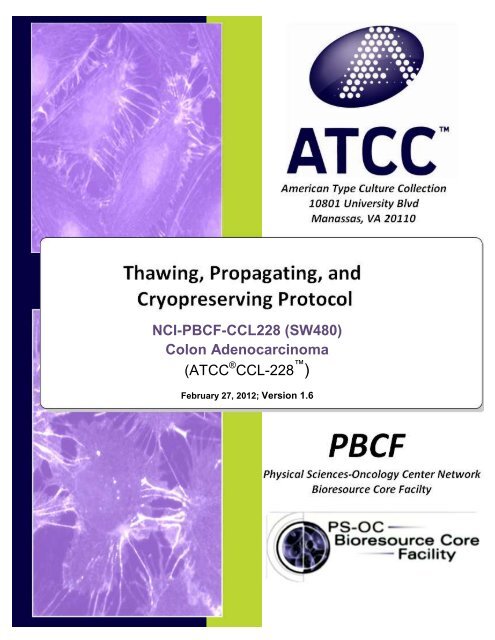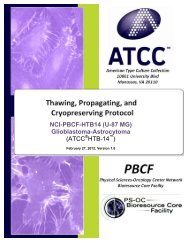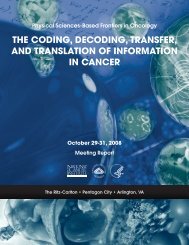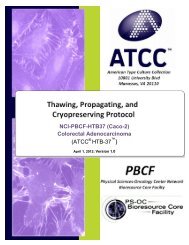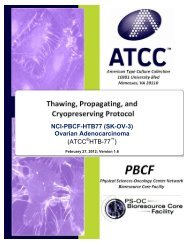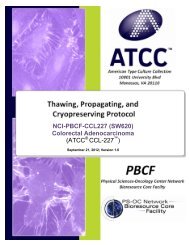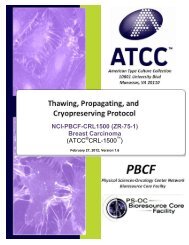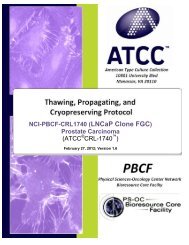SW480
SW480
SW480
Create successful ePaper yourself
Turn your PDF publications into a flip-book with our unique Google optimized e-Paper software.
NCI-PBCF-CCL228 (<strong>SW480</strong>)<br />
Colon Adenocarcinoma<br />
<br />
(ATCC ® CCL-228 )<br />
February 27, 2012; Version 1.6
Table of Contents<br />
1. BACKGROUND INFORMATION ON <strong>SW480</strong> CELL LINE ...................................................................3 <br />
2. GENERAL INFORMATION FOR THE THAWING, PROPAGATING AND CRYOPRESERVING OF<br />
NCI-PBCF- CCL228 (<strong>SW480</strong>) .......................................................................................................................3<br />
3. REAGENTS ...........................................................................................................................................5<br />
A. PREPARATION OF COMPLETE GROWTH MEDIUM (L-15 + 10 % (V/V) FBS) ...............................................6 <br />
4. THAWING AND PROPAGATION OF CELLS ......................................................................................6 <br />
A. THAWING CELLS ...................................................................................................................................6 <br />
B. PROPAGATING CELLS ...........................................................................................................................7 <br />
C. SUBCULTURING CELLS ..........................................................................................................................8 <br />
5. HARVESTING OF CELLS FOR CRYOPRESERVATION ....................................................................9 <br />
6. CRYOPRESERVATION OF CELLS .................................................................................................. 10<br />
A. CRYOPRESERVATION USING A RATE-CONTROLLED PROGRAMMABLE FREEZER ...................................... 11<br />
i. Using the Cryomed ..................................................................................................................... 11<br />
B. CRYOPRESERVATION USING “MR. FROSTY” ........................................................................................ 12<br />
7. STORAGE .......................................................................................................................................... 13<br />
APPENDIX 1: PHOTOMICROGRAPHS OF NCI-PBCF-CCL228 (<strong>SW480</strong>) CELLS ............................... 14<br />
APPENDIX 2: GROWTH PROFILE OF NCI-PBCF-CCL228 (<strong>SW480</strong>) CELLS ....................................... 16<br />
APPENDIX 3: CYTOGENETIC ANALYSIS OF NCI-PBCF-CCL228 <strong>SW480</strong> CELLS ............................. 17<br />
APPENDIX 4: GLOSSARY OF TERMS ................................................................................................... 20<br />
APPENDIX 5: REFERENCE ..................................................................................................................... 21<br />
APPENDIX 6: REAGENT LOT TRACEABILITY AND CELL EXPANSION TABLES ............................ 23<br />
APPENDIX 7: CALCULATION OF POPULATION DOUBLING LEVEL (PDL) ...................................... 25<br />
APPENDIX 8: SAFETY PRECAUTIONS ................................................................................................. 25
SOP: Thawing, Propagation and Cryopreservation of NCI-PBCF-CCL228 (<strong>SW480</strong>)<br />
Protocol for Thawing, Propagation and Cryopreservation of<br />
NCI-PBCF-CCL228 (<strong>SW480</strong>) (ATCC ® CCL-228 )<br />
colon adenocarcinoma<br />
1. Background Information on <strong>SW480</strong> cell line<br />
Designations:<br />
<strong>SW480</strong> [SW-480]<br />
Biosafety Level: 1<br />
Shipped:<br />
frozen (in dry ice)<br />
Growth Properties: Adherent (see Appendix 1)<br />
Organism:<br />
Homo sapiens<br />
Organ<br />
Source:<br />
Disease<br />
Derived from metastatic<br />
site:<br />
colon<br />
Dukes' type B<br />
colorectal adenocarcinoma<br />
For more information visit the ATCC webpage:<br />
http://www.atcc.org/ATCCAdvancedCatalogSearch/ProductDetails/tabid/452/Default.aspx?ATC<br />
CNum=CCL-228&Template=cellBiology<br />
2. General Information for the thawing, propagating and<br />
cryopreserving of NCI-PBCF- CCL228 (<strong>SW480</strong>)<br />
Culture Initiation<br />
Complete growth<br />
medium<br />
<br />
<br />
<br />
<br />
<br />
The cryoprotectant (DMSO) should be removed by centrifugation.<br />
The seeding density to use with a vial of <strong>SW480</strong> cells is about 5 x 10 5 viable cells/cm 2 or one<br />
vial into aT-25 flask containing 10 mL complete growth medium (L-15 + 10 % (v/v) FBS).<br />
The complete growth medium used to expand <strong>SW480</strong>cells is L-15 + 10 % (v/v) FBS.<br />
Complete growth medium (L-15 + 10 % (v/v) FBS) should be pre-warmed before use by placing<br />
into a water bath set at 35 o C to 37 o C for 15 min to 30 min.<br />
After 30 min, the complete growth medium (L-15 + 10 % (v/v) FBS) should be moved to room<br />
temperature until used. Complete growth medium (L-15 + 10 % (v/v) FBS) should be stored at 2<br />
o C to 8 o C when not in use.<br />
Cell Growth<br />
<br />
<br />
The growth temperature for <strong>SW480</strong> is 37 oC ± 1 oC<br />
100% air atmosphere ( without CO2) is recommended<br />
Growth Properties Population doubling time (PDT) is approximately 38 h (see Figure 4).<br />
Page 3 of 25
SOP: Thawing, Propagation and Cryopreservation of NCI-PBCF-CCL228 (<strong>SW480</strong>)<br />
Special Growth<br />
Requirements<br />
Subculture Medium<br />
Subculture Method<br />
Viable<br />
Cells/mL/Cryovial<br />
Cryopreservation<br />
Medium<br />
<br />
<br />
<br />
<br />
<br />
<br />
<br />
<br />
<br />
Subculture <strong>SW480</strong>cells at 80 % to 90 % confluence or when cell density reaches an average of<br />
5 x 10 5 viable cells/cm 2 .<br />
0.25 % (w/v) trypsin-0.53 mM EDTA (ATCC cat no. 30-2101).<br />
Subculturing reagents should be pre-warmed before use by placing into a water bath set at 35<br />
o C to 37 o C for 15 min to 30 min.<br />
After 30 min, the subculturing medium should be moved to room temperature until used.<br />
Subculturing reagents should be stored at 2 o C to 8 o C when not in use.<br />
The attached <strong>SW480</strong> cells are subcultured using 0.25 % (w/v) trypsin-0.53 mM EDTA (ATCC<br />
cat no. 30-2101).<br />
The enzymatic action of the trypsin-EDTA is stopped by adding complete growth medium to the<br />
detached cells.<br />
A split ratio of 1:10 to 1:12 or a seeding density of 4 x 10 4 viable cells/cm 2 to 5 x 10 5 viable<br />
cells/cm 2 is used when subculturing <strong>SW480</strong> cells.<br />
The target number of viable cells/mL/cryovial is: 2.0 x 10 6 (acceptable range: 2 x 10 6 viable<br />
cells/mL to 3 x 10 6 viable cells/mL).<br />
The cryopreservation medium for <strong>SW480</strong> cells is complete growth medium (L-15 + 10 % (v/v)<br />
FBS) containing 5 % (v/v) DMSO (ATCC cat no. 4-X).<br />
General Procedure to be applied throughout the SOP<br />
Aseptic Technique<br />
<br />
Use of good aseptic technique is critical. Any materials that are contaminated, as well as any<br />
materials with which they may have come into contact, must be disposed of immediately.<br />
Traceability of<br />
material/reagents<br />
<br />
Record the manufacturer, catalog number, lot number, date received, date expired and any<br />
other pertinent information for all materials and reagents used. Record information in the<br />
Reagent Lot Traceability Table 4 (Appendix 6).<br />
Expansion of cell line<br />
Record the subculture and growth expansion activities, such as passage number, %<br />
confluence, % viability, cell morphology (see Figures 1-3, Appendix 1) and population doubling<br />
levels (PDLs), in the table for Cell Expansion (Table 5, Appendix 6). Calculate PDLs using the<br />
equation in Appendix 7.<br />
Medium volumes Medium volumes are based on the flask size as outlined in Table 1.<br />
Glossary of Terms<br />
Safety Precaution<br />
<br />
<br />
Refer to Glossary of Terms used throughout the document (see Appendix 4).<br />
Refer to Safety Precautions pertaining to the thawing, propagating and cryopreserving of<br />
<strong>SW480</strong> (See Appendix 8).<br />
Page 4 of 25
SOP: Thawing, Propagation and Cryopreservation of NCI-PBCF-CCL228 (<strong>SW480</strong>)<br />
Table 1: Medium Volumes<br />
Flask Size<br />
Medium Volume Range<br />
12.5 cm 2 (T-12.5) 3 mL to 6 mL<br />
25 cm 2 (T-25) 5 mL to 13 mL<br />
75 cm 2 (T-75) 10 mL to 38 mL<br />
150 cm 2 (T-150) 30 mL to 75 mL<br />
175 cm 2 (T-175) 35 mL to 88 mL<br />
225 cm 2 (T-225) 45 mL to 113 mL<br />
3. Reagents<br />
Follow Product Information Sheet storage and/or thawing instructions. Below is a list of<br />
reagents for the propagation, subcultivation and cryopreservation of <strong>SW480</strong> cells.<br />
Table 2: Reagents for Expansion, Subculturing and Cryopreservation of<br />
<strong>SW480</strong> Cells<br />
Complete growth<br />
medium reagents<br />
Leibovitz’s L-15 Medium<br />
(ATCC cat no. 30-2008)<br />
Subculturing reagents<br />
Trypsin-EDTA (0.25 % (w/v)<br />
Trypsin/0.53 mM EDTA )<br />
(ATCC cat no.30-2101)<br />
Cryopreservation medium<br />
reagents<br />
Leibovitz’s L-15 Medium<br />
(ATCC cat no. 30-2008)<br />
10 % (v/v) Fetal Bovine<br />
Serum (FBS)<br />
(ATCC cat no. 30-2020)<br />
Dulbecco’s Phosphate Buffered<br />
Saline (DPBS); modified without<br />
calcium chloride and without<br />
magnesium chloride<br />
(ATCC cat no. 30-2200)<br />
10 % (v/v) FBS<br />
(ATCC cat no. 30-2020)<br />
5 % (v/v) Dimethyl Sulfoxide<br />
(DMSO)<br />
(ATCC cat no. 4-X)<br />
Page 5 of 25
SOP: Thawing, Propagation and Cryopreservation of NCI-PBCF-CCL228 (<strong>SW480</strong>)<br />
a. Preparation of complete growth medium (L-15 + 10 % (v/v) FBS)<br />
The complete growth medium is prepared by aseptically combining,<br />
1. 56 mL FBS (ATCC cat no. 30-2020) to a 500 mL bottle of basal medium; L-15 (ATCC cat<br />
no. 30-2008).<br />
2. Mix gently, by swirling.<br />
4. Thawing and Propagation of Cells<br />
Reagents and Material:<br />
<br />
<br />
<br />
<br />
<br />
Complete growth medium (L-15 + 10 % (v/v) FBS)<br />
Water bath<br />
T-25 cm 2 polystyrene flask <br />
15 mL polypropylene conical centrifuge tubes<br />
Plastic pipettes (1 mL,10 mL, 25 mL)<br />
a. Thawing cells<br />
Method:<br />
1. Place complete growth medium (L-15 + 10 % (v/v) FBS) in a water bath set at 35 o C to<br />
37 o C.<br />
2. Label T-25 flask to be used with the (a) name of cell line, (b) passage number, (c) date, (d)<br />
initials of technician.<br />
3. Wearing a full face shield, retrieve a vial of frozen cells from the vapor phase of the liquid<br />
nitrogen freezer.<br />
4. Thaw the vial by gentle agitation in a water bath set at 35 o C to 37 o C. To reduce the<br />
possibility of contamination, keep the O-ring and cap out of the water.<br />
Note: Thawing should be rapid (approximately 2 min to 3 min, just long enough for<br />
most of the ice to melt).<br />
5. Remove vial from the water bath and process immediately.<br />
6. Remove excess water from the vial by wiping with sterile gauze saturated with 70 % ethanol.<br />
7. Transfer the vial to a BSL-2 laminar-flow hood.<br />
Page 6 of 25
SOP: Thawing, Propagation and Cryopreservation of NCI-PBCF-CCL228 (<strong>SW480</strong>)<br />
b. Propagating cells<br />
Method:<br />
1. Add 9 mL of complete growth medium (L-15 + 10 % (v/v) FBS) to a 15-mL conical centrifuge<br />
tube.<br />
2. Again wipe the outer surface of the vial with sterile gauze wetted with 70 % ethanol.<br />
3. Using sterile gauze, carefully remove the cap from the vial.<br />
4. With a 1 mL pipette transfer slowly the completely thawed content of the vial (1 mL cell<br />
suspension) to the 15-mL conical centrifuge tube containing 9 mL complete growth medium<br />
(L-15 + 10 % (v/v) FBS). Gently resuspend cells by pipetting up and down.<br />
5. Centrifuge at 125 xg, at room temperature, for 8 min to 10 min.<br />
6. Carefully aspirate (discard) the medium, leaving the pellet undisturbed.<br />
7. Using a 10 mL pipette, add 10 mL of complete growth medium (L-15 + 10 % (v/v) FBS).<br />
8. Resuspend pellet by gentle pipetting up and down.<br />
9. Using a 1 mL pipette, remove 1 mL of cell suspension for cell count and viability. Cell counts<br />
are performed using either an automated counter (such as Innovatis Cedex System;<br />
Beckman-Coulter ViCell system) or a hemocytometer.<br />
10. Record total cell count and viability. When an automated system is used, attach copies of<br />
the printed results to the record.<br />
11. Plate cells in pre-labeled T-25 cm 2 flask at about 0.8 x 10 5 cells/cm 2 .<br />
12. Transfer flask to a 37 °C ± 1°C incubator without CO 2 .<br />
NOTE: The L-15 medium formulation was devised for use in a free gas exchange with<br />
atmospheric air. A CO 2 and air mixture is detrimental to cells when using this<br />
medium for cultivation.<br />
13. Observe culture daily by eye and under an inverted microscope to ensure culture is free of<br />
contamination and culture has not reached confluence. Monitor, visually, the pH of the<br />
medium daily. If the medium goes from red through orange to yellow, change the medium.<br />
14. Note: In most cases, cultures at a high cell density exhaust the medium faster than<br />
those at low cell density as is evident from the change in pH. A drop in pH is usually<br />
accompanied by an increase in cell density, which is an indicator to subculture the<br />
cells. Cells may stop growing when the pH is between pH 7 to pH 6 and loose<br />
viability between pH 6.5 and pH 6.<br />
15. If fluid renewal is needed, aseptically aspirate the complete growth medium from the flask<br />
and discard. Add an equivalent volume of fresh complete growth medium to the flask.<br />
Alternatively, perform a fluid addition by adding fresh complete growth medium to the flask<br />
Page 7 of 25
SOP: Thawing, Propagation and Cryopreservation of NCI-PBCF-CCL228 (<strong>SW480</strong>)<br />
without removing the existing medium. Record fluid change or fluid addition on the Cell Line<br />
Expansion Table (see Table 5 in Appendix 6).<br />
16. If subculturing of cells is needed, continue to ‘Subculturing cells’.<br />
Note: Subculture when the cells are 80-90 % confluent (see photomicrographs in<br />
Appendix 1).<br />
c. Subculturing cells<br />
Reagents and Material:<br />
<br />
<br />
<br />
<br />
<br />
0.25 % (w/v) Trypsin-0.53 mM EDTA<br />
DPBS<br />
Complete growth medium (L-15 (ATCC cat no. 30-2008) + 10 % (v/v) FBS (ATCC cat<br />
no. 30-2020)<br />
Plastic pipettes (1 mL, 10 mL, 25 mL)<br />
T-75 cm 2 , T-225 cm 2 polystyrene flasks <br />
Method:<br />
1. Aseptically remove medium from the flask<br />
2. Add appropriate volumes of sterile Ca 2+ - and Mg 2+ -free DPBS to the side of the flask<br />
opposite the cells so as to avoid dislodging the cells (see Table 3).<br />
3. Rinse the cells with DPBS (using a gently rocking motion) and discard.<br />
4. Add appropriate volume of 0.25 % (w/v) Trypsin-0.53 mM EDTA solution to the flask<br />
(see Table 3).<br />
5. Incubate the flask at 37 o C ± 1 o C until the cells round up. Observe cells under an<br />
inverted microscope every 5 min. When the flask is tilted, the attached cells should slide<br />
down the surface. This usually occurs after 5 min to 10 min of incubation.<br />
Note: Do not leave trypsin-EDTA on the cells any longer than necessary as<br />
clumping may result.<br />
6. Neutralize the trypsin-EDTA/cell suspension by adding an equal volume of complete<br />
growth medium (L-15 + 10 % (v/v) FBS) to each flask. Disperse the cells by pipetting,<br />
gently, over the surface of the monolayer. Pipette the cell suspension up and down with<br />
the tip of the pipette resting on the bottom corner or edge until a single cell suspension is<br />
obtained. Care should be taken to avoid the creation of foam.<br />
7. Using a 1 mL pipette, remove 1 mL of cell suspension for total cell count and viability.<br />
8. Record total cell count and viability.<br />
Page 8 of 25
SOP: Thawing, Propagation and Cryopreservation of NCI-PBCF-CCL228 (<strong>SW480</strong>)<br />
9. Add appropriate volume of fresh complete growth medium (L-15 + 10 % (v/v) FBS) and<br />
transfer cell suspension (for volume see Table 1) into new pre-labeled flasks at a<br />
seeding density of 4 x 10 4 viable cells/cm 2 to 5 x 10 4 viable cells/cm 2 or a split ratio of<br />
1:10 to 1:12.<br />
10. Label all new flasks with the (a) name of cell line, (b) passage number, (c) date, (d)<br />
initials of technician.<br />
Table 3 - Volume of Rinse Buffer and Trypsin<br />
Flask<br />
Type<br />
Flask<br />
Size<br />
DPBS Rinse<br />
Buffer<br />
Trypsin-EDTA<br />
T-flask 12.5 cm 2 (T-12.5) 1 mL to 3 mL 1 mL to 2 mL<br />
25 cm 2 (T-25) 1 mL to 5 mL 1 mL to 3 mL<br />
75 cm 2 (T-75) 4 mL to 15 mL 2 mL to 8 mL<br />
150 cm 2 (T-150) 8 mL to 30 mL 4 mL to 15 mL<br />
175 cm 2 (T-175) 9 mL to 35 mL 5 mL to 20 mL<br />
225 cm 2 (T-225) 10 mL to 45 mL 5 mL to 25 mL<br />
5. Harvesting of Cells for Cryopreservation<br />
Reagents and Material:<br />
<br />
<br />
<br />
<br />
<br />
<br />
<br />
<br />
0.25 % (w/v) Trypsin-0.53 mM EDTA<br />
DPBS<br />
Complete growth medium (L-15 (ATCC cat no. 30-2008) + 10 % (v/v) FBS (ATCC cat<br />
no. 30-2020)<br />
50 mL or 250 mL conical centrifuge tube<br />
Plastic pipettes (1 mL, 10 mL, 25 mL)<br />
Sterile DMSO<br />
1 mL to 1.8 mL cryovials<br />
Ice bucket with ice<br />
Method:<br />
1. Label cryovials to include information on the:<br />
name of cell line, (b) passage number (c) date.<br />
2. Prepare cryopreservation medium by adding DMSO to cold complete growth medium (L<br />
15 + 10 % (v/v) FBS) at a final concentration of 5 % (v/v) DMSO. Place cryopreservation<br />
medium on ice until ready to use.<br />
Page 9 of 25
SOP: Thawing, Propagation and Cryopreservation of NCI-PBCF-CCL228 (<strong>SW480</strong>)<br />
3. Aseptically remove medium from the flask.<br />
4. Add appropriate volumes of sterile Ca 2+ - and Mg 2+ -free DPBS to the side of the flask so<br />
as to avoid dislodging the cells (see Table 3).<br />
5. Rinse the cells with DPBS (using a gentle rocking motion) and discard.<br />
6. Add appropriate volume of 0.25 % (w/v) Trypsin-0.53 mM EDTA solution to the flask<br />
(see Table 3).<br />
7. Incubate the flask at 37 o C ± 1 o C until the cells round up. Observe cells under an<br />
inverted microscope every 5 min. When the flask is tilted, the attached cells should slide<br />
down the surface. This usually occurs after 5 min to 10 min of incubation.<br />
Note: Do not leave trypsin-EDTA on the cells any longer than necessary as<br />
clumping may result.<br />
8. Neutralize the trypsin-EDTA/cell suspension by adding an equal volume of complete<br />
growth medium (L-15 + 10 % (v/v) FBS) to each flask. Disperse the cells by pipetting,<br />
gently, over the surface of the monolayer. Pipette the cell suspension up and down with<br />
the tip of the pipette resting on the bottom corner or edge until a single cell suspension is<br />
obtained. Care should be taken to avoid the creation of foam.<br />
9. Using a 1 mL pipette, remove 1 mL of cell suspension for total cell count and viability.<br />
10. Record total cell count and viability.<br />
11. Spin cells at approximately 125 xg for 5 min to 10 min at room temperature. Carefully<br />
aspirate and discard the medium, leaving the pellet undisturbed<br />
12. Calculate volume of cryopreservation medium based on the count performed at step 9<br />
and resuspend pellet in cold cryopreservation medium at a viable cell density of 2 x 10 6<br />
viable cells/mL (acceptable range: 2 x 10 6 viable cells/mL to 3 x 10 6 viable cells/mL) by<br />
gentle pipetting up and down..<br />
13. Dispense 1 mL of cell suspension, using a 5 mL or 10 mL pipette, into each 1 mL<br />
cryovial.<br />
14. Place filled cryovials at 2 o C to 8 o C until ready to cryopreserve. A minimum equilibration<br />
time of 10 min but no longer than 45 min is necessary to allow DMSO to penetrate the<br />
cells.<br />
Note: DMSO is toxic to the cells. Long exposure in DMSO may affect viability.<br />
6. Cryopreservation of Cells<br />
Material:<br />
Liquid nitrogen freezer<br />
Cryomed Programmable freezer (Forma Scientific, cat no. 1010) or <br />
Mr. Frosty (Nalgene, cat no. 5100)<br />
Page 10 of 25
SOP: Thawing, Propagation and Cryopreservation of NCI-PBCF-CCL228 (<strong>SW480</strong>)<br />
<br />
<br />
Isopropanol<br />
Cryovial rack<br />
a. Cryopreservation using a rate-controlled programmable <br />
freezerMethod:<br />
A slow and reproducible cooling rate is very important to ensure good recovery of cultures.<br />
A decrease of 1 °C per min to -80 °C followed by rapid freeze at about 15 °C to 30 °C per<br />
min drop to -150 °C will usually work for most animal cell cultures. The best way to control<br />
the cooling process is to use a programmable, rate-controlled, electronic freezer unit. Refer<br />
to the manufacturer’s handbook for detailed procedure.<br />
i. Using the Cryomed<br />
Starting the Cryopreservation Process<br />
1. Check that the liquid nitrogen valve that supplies the Cryomed is open.<br />
2. Check the gauge to ensure that there is enough liquid nitrogen in the open tank to<br />
complete the freeze.<br />
3. Install the thermocouple probe so that the tip is immersed midway into the control fluid<br />
Note: Be sure that the thermocouple is centered in the vial and the vial is placed<br />
centered in the rack. The probe should be changed after three uses or if it turns<br />
yellow to ensure accurate readings by the controller during the freezing process.<br />
Old medium may have different freezing characteristics.<br />
4. Close and latch Cryomed door.<br />
5. Turn on microcomputer, computer and monitor.<br />
6. Double click the “Cryomed” icon. The machine may need to be pre-programmed for<br />
specific cell type and medium.<br />
7. From the top of the screen, select MENU RUN FUNCTIONS START RUN.<br />
8. Fill out the box which appears on the screen. Cell line ID; TYPE OF SAMPLE; MEDIA;<br />
NUMBER OF SAMPLES.<br />
9. Hit the ESCAPE key and the Cryomed will cool to 4 C.<br />
10. Once Cryomed chamber has cooled to 4 C, load cryovials onto racks and close the<br />
door.<br />
11. When the Cryomed’s chamber temperature and the sample temperature have reached<br />
approximately 4 C; press the space bar to initiate the rate controlled cryopreservation<br />
process.<br />
Page 11 of 25
SOP: Thawing, Propagation and Cryopreservation of NCI-PBCF-CCL228 (<strong>SW480</strong>)<br />
Completing the Cryopreservation Process<br />
1. When samples have reached –80C, an alarm will sound. To silence this, select ALARM<br />
from the options at the top of the screen.<br />
2. Select MENU RUN FUNCTIONS→ STOP. Hit the ESCAPE key to return to the main<br />
menu and select EXIT.<br />
3. Immediately transfer vials to liquid nitrogen freezer.<br />
4. Shut down the microcomputer and then turn off the monitor.<br />
b. Cryopreservation using “Mr. Frosty”<br />
1. One day before freezing cells, add 250 mL isopropanol to the bottom of the container<br />
and place at 2 o C to 8 o C.<br />
2. On the day of the freeze, prepare cells for cryopreservation as described above.<br />
3. Insert cryovials with the cell suspension in appropriate slots in the container.<br />
4. Transfer the container to a -70 °C to -90 °C freezer and store overnight.<br />
5. Next day, transfer cryovials to the vapor phase of liquid nitrogen freezer.<br />
Note: Each container has 18 slots which can accommodate 18 cryovials in one<br />
freeze.<br />
Important information when using the rate-controlled programmable freezer or a<br />
manual method (Mr. Frosty) for cryopreservation of mammalian cells.<br />
Regardless which cooling method is used, it is important that the transfer to the final<br />
storage location (between -130 °C and -196 °C) be done quickly and efficiently. If the<br />
transfer cannot be done immediately, the vials can be placed on dry ice for a short time.<br />
This will avoid damage to cultures by inadvertent temporary warming during the transfer<br />
process. Warming during this transfer process is a major cause of variation in culture<br />
viability upon thawing.<br />
Always keep the storage temperature below -130 °C for optimum survival. Cells may<br />
survive storage at higher temperatures but viability will usually decrease over time. The<br />
ideal storage container is a liquid nitrogen freezer where the cultures are stored in the<br />
vapor phase above the liquid nitrogen.<br />
Note: ATCC does not have experience in the cryopreservation of the <strong>SW480</strong> cells by<br />
any other method than the Cryomed programmable freezer.<br />
Page 12 of 25
SOP: Thawing, Propagation and Cryopreservation of NCI-PBCF-CCL228 (<strong>SW480</strong>)<br />
7. Storage<br />
Store cryopreserved cells in the vapor phase of liquid nitrogen freezer (below –130 °C) for<br />
optimum long-term survival.<br />
Note: Experiments on long-term storage of animal cell lines at different temperature<br />
levels indicate that a -70 °C storage temperature is not adequate except for very short<br />
period of time. A -90 °C storage may be adequate for longer periods depending upon<br />
the cell line preserved. The efficiency of recovery, however, is not as great as when<br />
the cells are stored in vapor phase of the liquid nitrogen freezer.<br />
Page 13 of 25
SOP: Thawing, Propagation and Cryopreservation of NCI-PBCF-CCL228<br />
(<strong>SW480</strong>)<br />
APPENDIX 1: PHOTOMICROGRAPHS OF NCI-PBCF-CCL228 (<strong>SW480</strong>) CELLS<br />
Figure 1: Photomicrograph of <strong>SW480</strong> cells after one day, post-freeze<br />
recovery. Cells were plated at 8.0 x 10 4 viable cells/cm 2 .<br />
Figure 2: Photomicrograph of <strong>SW480</strong> cells after two days, post-freeze<br />
recovery. Cells were plated at 8.0 x 10 4 viable cells/cm 2 .<br />
Page 14 of 25
SOP: Thawing, Propagation and Cryopreservation of NCI-PBCF-CCL228<br />
(<strong>SW480</strong>)<br />
40X 40X 40X<br />
500 µm<br />
500 µm<br />
500 µm<br />
100X 100X 100X<br />
200 µm 200 µm 200 µm<br />
Figure 3: Photomicrographs of <strong>SW480</strong> cells at various time points after<br />
seeding at a cell density of 5 x 10 4 viable cells/cm 2 .<br />
Page 15 of 25
SOP: Thawing, Propagation and Cryopreservation of NCI-PBCF-CCL228<br />
(<strong>SW480</strong>)<br />
APPENDIX 2: GROWTH PROFILE OF NCI-PBCF-CCL228 (<strong>SW480</strong>) CELLS<br />
1.00E+06<br />
9.00E+05<br />
8.00E+05<br />
7.00E+05<br />
Viable Cells/cm 2<br />
6.00E+05<br />
5.00E+05<br />
4.00E+05<br />
3.00E+05<br />
2.00E+05<br />
1.00E+05<br />
0.00E+00<br />
0 1 2 3 4 5 6<br />
Days in Culture<br />
7 8 9<br />
Figure 4: Growth curve for <strong>SW480</strong> cells; cells were plated at 5 x 10 4 viable<br />
cells/cm 2 ; population doubling time (PDT) is approximately 38 h.<br />
Page 16 of 25
SOP: Thawing, Propagation and Cryopreservation of NCI-PBCF-CCL228<br />
(<strong>SW480</strong>)<br />
APPENDIX 3: CYTOGENETIC ANALYSIS OF NCI-PBCF-CCL228 <strong>SW480</strong> CELLS<br />
NCI-PBCF-CCL228 Karyotype Results<br />
Metaphase Spread<br />
Karyotype<br />
Number of metaphase spreads counted 20<br />
Band level 300-400<br />
Number of metaphase spreads karyotyped 10<br />
Chromosome range 50-56<br />
Sex<br />
Comments<br />
Male<br />
Aneuploid*<br />
Karyotype:<br />
50~56,XX,+2,der(2)t(2;18)(q21;q11.1),del(5)(q13q33),+add(7)(q22),+add(7)(q32),<br />
der(10)t (10;12)(p15;q11),+add(11)(p15),-12,der(12;14)(p10;q10),-14,+add(15)(p10),<br />
der(15)t(12;15)(q13;q15),-18,add(19)(p13.3),+20,+add(20)(p13),<br />
+der(20)t(5;20)(q22;p13)x2,+21,+add(21)(q11.1),add(21)(q22),+mar1x2<br />
(ISCN nomenclature written based on a diploid karyotype).<br />
*Human diploid karyotype (2N): 46,XX (female) or 46,XY (male)<br />
Page 17 of 25
SOP: Thawing, Propagation and Cryopreservation of NCI-PBCF-CCL228<br />
(<strong>SW480</strong>)<br />
Karyotype Summary:<br />
In the karyotype image, arrows indicate regions of abnormality. It should be noted that the<br />
karyotype description includes the observed abnormalities from all examined metaphase<br />
spreads, but due to heterogeneity, not all of the karyotyped cells will contain every<br />
abnormality.<br />
This is a rearranged human cell line of male origin containing 50 to 56 chromosomes per<br />
metaphase spread (hyperdiploid). Structural abnormalities include rearrangements to<br />
approximately 50% of the 22 different autosomal chromosomes (described below). There is<br />
one unidentifiable clonal marker chromosome (markers present in two or more of the<br />
examined cells) [+mar1].<br />
The rearrangements include:<br />
Addition of unknown material to the short arms (designated by p) of chromosomes 11,<br />
15, 19 and 20;<br />
Addition of unknown material to the long arms (designated by q) of chromosomes 7<br />
and 21 (2 different derivatives of each) ;<br />
An interstitial deletion of material from the long arm of chromosome 5 between bands<br />
q13 and q33;<br />
Translocations involving chromosomes 2 and 18 [der(2)t(2;18)(q21;q11.1)], 10 and 12<br />
[der(10)t (10;12)(p15;q11), chromosomes 12 and 14 [der(12;14)(p10;q10)], 12 and 15<br />
[der(15)t(12;15)(q13;q15)], and chromosomes 5 and 20 [der(20)t(5;20)(q22;p13)].<br />
Numerical changes are based on a diploid karyotype which would contain two copies of<br />
each chromosome (2N). Therefore, karyotype designations such as +2, +20 and +21,<br />
indicates three copies of structurally normal chromosomes 2, 20 and 21. Designations<br />
-18 and -14 indicates one copy of structurally normal chromosomes -18 and -14. Also, it<br />
appears that the Y chromosome was lost which is not an uncommon occurrence in cancer<br />
cell lines. (ISCN 2009: An International System for Human Cytogenetic Nomenclature<br />
(2009), Editors: Lisa G. Shaffer, Marilyn L. Slovak, Lynda J. Campbell)<br />
Karyotype Procedure:<br />
Cell Harvest: Cells were allowed to grow to 80-90% confluence. Mitotic division was<br />
arrested by treating the cells with KaryoMax® colcemid for 20 minutes to 2 hours at 37°C.<br />
Cells were harvested using 0.05% Trypsin-EDTA, treated with 0.075M KCL hypotonic<br />
solution, and then fixed in three changes of a 3:1 ratio of methanol;glacial acetic acid.<br />
Slide Preparation: Slides were prepared by dropping the cell suspension onto wet glass<br />
slides and allowing them to dry under controlled conditions.<br />
G-banding: Slides were baked one hour at 90°C, trypsinized using 10X trypsin-EDTA,<br />
and then stained with Leishman’s stain.<br />
Page 18 of 25
SOP: Thawing, Propagation and Cryopreservation of NCI-PBCF-CCL228<br />
(<strong>SW480</strong>)<br />
Microscopy: Slides were scanned using a 10X objective and metaphase spreads were<br />
analyzed using a 100X plan apochromat objective on an Olympus BX-41 microscope.<br />
Imaging and karyotyping were performed using Cytovision® software.<br />
Analysis: Twenty metaphase cells were counted and analyzed, and representative<br />
metaphase cells were karyotyped depending on the complexity of the study.<br />
Summary of Karyotyping Procedure:<br />
G-band karyotyping analysis is performed using GTL banding technique: G bands produced<br />
with trypsin and Leishman. Slides prepared with metaphase spreads are treated with trypsin<br />
and stained with Leishman’s. This method produces a series of light and dark bands that<br />
allow for the positive identification of each chromosome.<br />
<strong>SW480</strong> cell line karyotyping was carried out by Cell Line Genetics, Inc. (Madison, WI<br />
53719)<br />
Page 19 of 25
SOP: Thawing, Propagation and Cryopreservation of NCI-PBCF-CCL228<br />
(<strong>SW480</strong>)<br />
APPENDIX 4: GLOSSARY OF TERMS<br />
Confluent monolayer: adherent cell culture in which all cells are in contact with other cells<br />
all around their periphery and no available substrate is left uncovered.<br />
Split ratio: the divisor of the dilution ration of a cell culture to subculture (e.g., one flask<br />
divided into four, or 100 mL up to 400 mL, would be split ratio of 1:4).<br />
Subculture (or passage): the transfer or transplantation of cells, with or without dilution,<br />
from one culture vessel to another.<br />
Passage No: the total number of times the cells in the culture have been subcultured or<br />
passaged (with each subculture the passage number increases by 1).<br />
Population doubling level (PDL): the total number of population doublings of a cell line<br />
since its initiation in vitro (with each subculture the population doubling increases in<br />
relationship to the split ratio at which the cells are plated). See Appendix 7.<br />
Population doubling time (doubling time): the time interval, calculated during the<br />
logarithmic phase of growth in which cells double in number.<br />
Seeding density: recommended number of cells per cm 2 of substrate when inoculating a<br />
new flask.<br />
Epithelial-like: adherent cells of a polygonal shape with clear, sharp boundaries between<br />
them.<br />
Fibroblast-like: adherent cells of a spindle or stellate shape.<br />
Page 20 of 25
SOP: Thawing, Propagation and Cryopreservation of NCI-PBCF-CCL228<br />
(<strong>SW480</strong>)<br />
APPENDIX 5: REFERENCE<br />
1. Culture Of Animal Cells: A Manual of Basic Technique by R. Ian Freshney, 6th edition,<br />
published by Wiley-Liss, N.Y., 2010.<br />
2. Fogh J, et al. Absence of HeLa cell contamination in 169 cell lines derived from human<br />
tumors. J. Natl. Cancer Inst. 58: 209-214, 1977. PubMed: 833871<br />
3. Fogh J, et al. One hundred and twenty-seven cultured human tumor cell lines producing<br />
tumors in nude mice. J. Natl. Cancer Inst. 59: 221-226, 1977. PubMed: 327080<br />
4. Lelbovitz A, et al. Detection and analysis of a glucose 6-phosphate dehydrogenase<br />
phenotype B cell line contamination. J. Natl. Cancer Inst. 63: 635-645, 1979. PubMed:<br />
288927<br />
5. Adachi A, et al. Productive, persistent infection of human colorectal cell lines with human<br />
immunodeficiency virus. J. Virol. 61: 209-213, 1987. PubMed: 3640832<br />
6. Schroy PC, et al. Detection of p21ras mutations in colorectal adenomas and carcinomas<br />
by enzyme-linked immunosorbent assay. Cancer 76: 201-209, 1995. PubMed: 8625092<br />
7. Trainer DL, et al. Biological characterization and oncogene expression in human<br />
colorectal carcinoma cell lines. Int. J. Cancer 41: 287-296, 1988. PubMed: 3338874<br />
8. Weiss J, et al. Mutation and expression of the p53 gene in malignant melanoma cell<br />
lines. Int. J. Cancer 54: 693-699, 1993. PubMed: 8514460<br />
9. Nigro JM, et al. Mutations in the p53 gene occur in diverse human tumour types. Nature<br />
342: 705-707, 1989. PubMed: 2531845<br />
10. Barnett SW, et al. Characterization of human immunodeficiency virus type 1 strains<br />
recovered from the bowel of infected individuals. Virology 182: 802-809, 1991. PubMed:<br />
2024498<br />
11. Leibovitz A, et al. Classification of human colorectal adenocarcinoma cell lines. Cancer<br />
Res. 36: 4562-4569, 1976. PubMed: 1000501<br />
12. Geiser AG, et al. Suppression of tumorigenicity in human cell hybrids derived from cell<br />
lines expressing different activated ras oncogenes. Cancer Res. 49: 1572-1577, 1989.<br />
PubMed: 2647289<br />
13. Lahm H, et al. Secretion of bioactive granulocyte-macrophage colony-stimulating factor<br />
by human colorectal carcinoma cells. Cancer Res. 54: 3700-3702, 1994. PubMed:<br />
8033086<br />
14. Rodrigues NR, et al. p53 mutations in colorectal cancer. Proc. Natl. Acad. Sci. USA 87:<br />
7555-7559, 1990. PubMed: 1699228<br />
Page 21 of 25
SOP: Thawing, Propagation and Cryopreservation of NCI-PBCF-CCL228<br />
(<strong>SW480</strong>)<br />
15. Santoro IM, Groden J. Alternative splicing of the APC gene and its association with <br />
terminal differentiation. Cancer Res. 57: 488-494, 1997. PubMed: 9012479<br />
16. Tsao H, et al. Novel mutations in the p16/CDKN2A binding region of the Cyclindependent<br />
Kinase-4 gene. Cancer Res. 58: 109-113, 1998. PubMed: 9426066<br />
17. Zhu X, et al. Cell cycle-dependent modulation of telomerase activity in tumor cells. Proc.<br />
Natl. Acad. Sci. USA 93: 6091-6095, 1996. PubMed: 8650224<br />
18. Witty JP, et al. Modulation of matrilysin levels in colon carcinoma cell lines affects<br />
tumorigenicity in vivo. Cancer Res. 54: 4805-4812, 1994. PubMed: 8062282<br />
Page 22 of 25
SOP: Thawing, Propagation and Cryopreservation of NCI-PBCF-CCL228<br />
(<strong>SW480</strong>)<br />
APPENDIX 6: REAGENT LOT TRACEABILITY AND CELL EXPANSION TABLES<br />
Table 4: Reagent Lot Traceability<br />
Reagent Vendor Catalog # Lot # Expiration<br />
Date<br />
Page 23 of 25
Table 5: Cell Expansion<br />
FROM<br />
FLUID CHANGE<br />
Observation under<br />
microscope CELL COUNT TO<br />
By / Date<br />
Flask qty;<br />
size<br />
Pass # %<br />
Confluence<br />
Add/<br />
Replace<br />
Volume<br />
(in mL)<br />
Viable<br />
cells/mL<br />
Total<br />
viable<br />
cells<br />
%<br />
Viability<br />
Split<br />
Ratio<br />
Flask<br />
qty;<br />
size<br />
Pass #<br />
PDL#<br />
Add /<br />
Replace<br />
Add /<br />
Replace<br />
Add /<br />
Replace<br />
Add /<br />
Replace<br />
Add /<br />
Replace<br />
Add /<br />
Replace<br />
Add /<br />
Replace<br />
Add /<br />
Replace<br />
Add /<br />
Replace
SOP: Thawing, Propagation and Cryopreservation of NCI-PBCF-CCL228 (<strong>SW480</strong>)<br />
APPENDIX 7: CALCULATION OF POPULATION DOUBLING LEVEL (PDL)<br />
Calculate the PDL of the current passage using the following equation:<br />
PDL = X + 3.322 (log Y – log I)<br />
Where:<br />
X = initial PDL<br />
I = cell inoculum (number of cells plated in the flask)<br />
Y = final cell yield (number of cells at the end of the growth period)<br />
APPENDIX 8: SAFETY PRECAUTIONS<br />
Use at least approved Biological Safety Level 2 (BSL-2) facilities and procedures.<br />
Wear appropriate Personal Protective Equipment (PPE), such as isolation gown, lab coat<br />
with sleeve protectors, face shield and gloves.<br />
Use safety precautions when working with liquid nitrogen, nitrogen vapor and cryogenically<br />
cooled fixtures.<br />
Use liquid nitrogen freezers and liquid nitrogen tanks only in areas with adequate ventilation.<br />
Liquid nitrogen reduces the concentration of oxygen and can cause suffocation.<br />
Wear latex gloves over insulating gloves to prevent liquid nitrogen from soaking in and being<br />
held next to the skin. Liquid nitrogen is extremely cold and will cause burns and frostbite.<br />
Metal inventory racks, tank components, and liquid nitrogen transfer hoses exposed to liquid<br />
nitrogen or nitrogen vapor quickly cool to cryogenic temperatures and can cause burns and<br />
frostbite.<br />
Wear a full face mask when thawing and retrieving vials from liquid nitrogen freezer. Danger<br />
to the technician derives mainly from the possibility that liquid nitrogen can penetrate the<br />
cryovial during storage. On warming, rapid evaporation of the nitrogen within the confines of<br />
such cryovial can cause an aerosol or explosion of the cryovial and contents.<br />
Page 25 of 25


